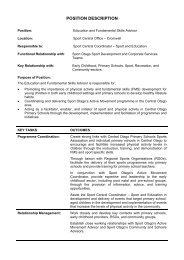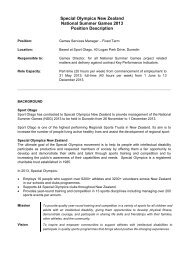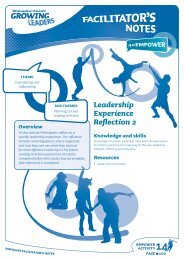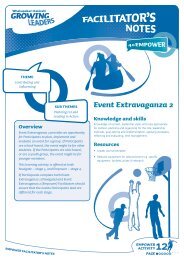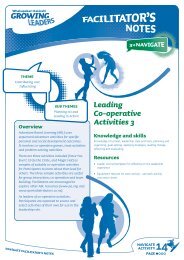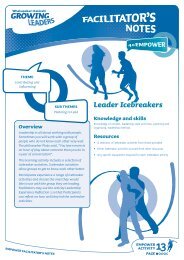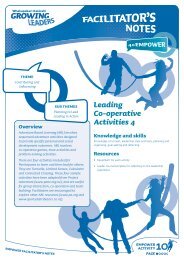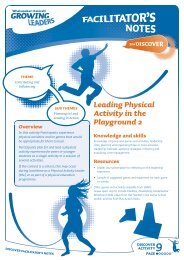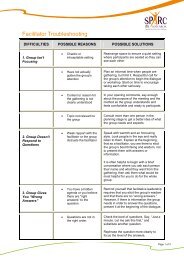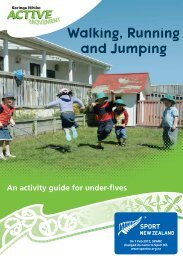Read Getting Set for an Active Nation - Sport New Zealand
Read Getting Set for an Active Nation - Sport New Zealand
Read Getting Set for an Active Nation - Sport New Zealand
Create successful ePaper yourself
Turn your PDF publications into a flip-book with our unique Google optimized e-Paper software.
certain sports is reflected in other newspaper records of the day, such as in the <strong>New</strong> Zeal<strong>an</strong>d<br />
Herald of 27 May, 1878, which noted the Tradesmen’s Athletic Club at Ellerslie <strong>an</strong>d the<br />
Pakur<strong>an</strong>ga Hunt Club. The same issue, along with the selling of crime<strong>an</strong> shirts <strong>an</strong>d boys’<br />
knickerbocker suits, made reference to M<strong>an</strong>-of-War boating races <strong>an</strong>d local football.<br />
Expenditure on sport was reflected in the 33,500 pounds spent at Otago race tracks in 1873,<br />
in <strong>an</strong> era when footracers earned cash from professional racing (Craw<strong>for</strong>d, 1984). As in the<br />
United States of America, Australia <strong>an</strong>d the United Kingdom, sports in <strong>New</strong> Zeal<strong>an</strong>d society<br />
were seen as positive <strong>for</strong>ces which enh<strong>an</strong>ced “healthy living” <strong>an</strong>d countered the excessive<br />
lures of alcohol <strong>an</strong>d tobacco.<br />
The concept of mateship in the twenty-first century, in sports such as rugby <strong>an</strong>d rugby<br />
league, is seen as having its roots in the frontier society of nineteenth century <strong>New</strong> Zeal<strong>an</strong>d.<br />
Frontier life was also characterised by unattached males, the telling of yarns <strong>an</strong>d in<strong>for</strong>mal<br />
physical recreation such as picnic events, hunting, local competition, drinking, <strong>an</strong>d local rules<br />
in games. Church, <strong>an</strong>nual community events <strong>an</strong>d the occasional touring comp<strong>an</strong>y<br />
per<strong>for</strong>m<strong>an</strong>ce provided focal points <strong>for</strong> families.<br />
Water based <strong>an</strong>d team sports were popular <strong>an</strong>d newspapers recorded large attend<strong>an</strong>ces at<br />
rugby matches, athletic meets <strong>an</strong>d horse racing. As was to be noted in the twentieth century,<br />
participation of all sectors of the <strong>New</strong> Zeal<strong>an</strong>d population in particular nineteenth century<br />
sports was influenced by work hours, race, disposable income <strong>an</strong>d education background.<br />
Histori<strong>an</strong>s have noted the marginalisation of women in recreation <strong>an</strong>d sport, with little<br />
recognition in historical literature given to their pursuits.<br />
Industralised societal values such as the division of labour, recognition <strong>for</strong> hard work, set<br />
times governing daily routines, <strong>an</strong>d increasing regulation are seen by recreation <strong>an</strong>d sport<br />
sociologists as influencing the shape of non-work activity <strong>an</strong>d the setting up of associations<br />
with rules <strong>an</strong>d s<strong>an</strong>ctions. By the end of the nineteenth century national associations were<br />
being <strong>for</strong>med. Improved communications, increasing tr<strong>an</strong>sport linkages, technology adv<strong>an</strong>ces<br />
<strong>an</strong>d the installation of central government enh<strong>an</strong>ced the development of sport uni<strong>for</strong>mity <strong>an</strong>d<br />
competition structures. In 1892 a government bill was passed to allow shops to close at 1:00<br />
pm on Saturdays. The growth of secondary schooling, with its attend<strong>an</strong>t con<strong>for</strong>mity, provided<br />
pools of potential players <strong>an</strong>d strengthened the st<strong>an</strong>dardisation of rules. The increasing<br />
regulation of society was reflected in the <strong>for</strong>mation of national <strong>an</strong>d regional bodies, such as:<br />
Auckl<strong>an</strong>d Athletics Association (1887); Amateur Rowing Association (1887); Swimming<br />
Association (1889); Football (Soccer) Association (1891); Rugby Football Union (1892); Alpine<br />
Club (1892); <strong>an</strong>d the Cricket Council (1894). A wide r<strong>an</strong>ge of institutions also accepted the<br />
positive values of play <strong>an</strong>d recreation, illustrated by the Dunedin Curative Asylum in 1875<br />
having activities such as bowls, croquet <strong>an</strong>d rambling. Cycling had become popular with the<br />
advent of the penny-farthing cycle <strong>an</strong>d grew in popularity with subsequent improved models.<br />
This invention also impacted upon the mobility of women <strong>an</strong>d their ability to gather <strong>for</strong><br />
recreation <strong>an</strong>d sport. The increase in org<strong>an</strong>ised recreation <strong>an</strong>d sport reflected a belief that<br />
activity had social benefits, including community cohesion.<br />
There are clear parallels in <strong>New</strong> Zeal<strong>an</strong>d’s sport development with those of org<strong>an</strong>ised sport in<br />
nineteenth century Europe. The mass movement of sport grew apace in both settings.<br />
Communication <strong>an</strong>d tr<strong>an</strong>sport adv<strong>an</strong>ces facilitated international sport competition <strong>an</strong>d the<br />
st<strong>an</strong>dardisation of rules <strong>an</strong>d records. The increases in Australasi<strong>an</strong> sports org<strong>an</strong>isation in this<br />
Ministerial Task<strong>for</strong>ce on <strong>Sport</strong>, Fitness & Leisure J<strong>an</strong>uary 2001 page 18 of 153




